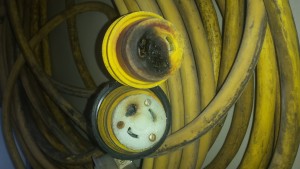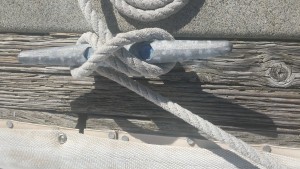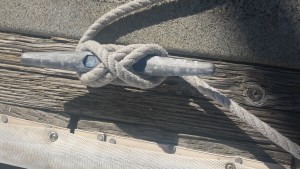I am always amazed at how often a small error committed on a sailboat results in major difficulties.
A couple of weeks ago, while crewing for another skipper, I was assigned the task of releasing the bow line in preparation for departure. Unfortunately, the cleat hitch had been set up incorrectly. Instead of leading the line to the shoulder of the cleat furthest from the origination of the line, the hitch was put on from the closest shoulder. It was then wrapped all the way around the cleat before the “crossing” turns were put on. The net result was two lines trying to occupy the same limited space under the cleat and jamming against one another. The line was jammed so badly the line needed to be cut to release it. In this case, not a major difficulty, just an expensive dock line needing replacement. What would the result have been if that line needed to be released in a hurry because of an emergency?
About two in the morning, while on a broad reach in 25-30 knots of wind, a jib sheet pulled itself out of the self tailing jaws, unwound itself from the winch and went flying, right through the jib track fair lead, stopper knot and all, and into a nasty tangle at the clew of the jib. We were not able to untangle the mess at night on a pitching deck. Fortunately, we were able to furl the jib and sail the rest of the way to Monterey on mainsail alone. The crew member responsible learned a valuable lesson that day. Two wraps on a winch are not enough on any boat bigger than 25 feet! We were on a 43 foot boat with winches designed for four wraps. Anything less was dangerous! As I reflect on that incident, I realize how lucky we were. The sheet went straight forward. It could easily have whipped across the cockpit instead.
Ever seen what happens if you let go of a steering wheel while going astern? Broken steering cables, steering quadrants torn from their mounts, and rudder posts broken loose from the rudder are all possible results. All problems that are major and easily prevented by keeping one hand on the wheel at all times.
 This one caught me by surprise. Actually, it’s not one, it was three! Three times in the past two weeks the shore power on a Tradewinds boat has been plugged in incorrectly. Two of them the same day! This picture captures the result of those two. Apparently, instead of being plugged in properly, the plug was rotated one third of the way around and “forced” into the socket. In each case, the “Reverse Polarity” light was lit, indicating a problem, and in each case it was either not seen or ignored. Fortunately, the problem was found before the boats caught fire, however, as you can see, it wasn’t far from happening. The right way begins with disconnecting properly. Start by locating the boat’s Reverse Polarity light. If there is one, it should be near the AC Main switch. Turn off the boat’s AC Main switch. Turn off the AC power at the dock box. It is now safe to disconnect the shore power cord. To connect to shore power reverse the above sequence. Plug the shore power cord into the boat (and the shore power box if needed). Both AC switches, boat and shore, must be in the off position while these connections are made. Turn on the switch at the shore power box. Last, turn on the boat’s AC Main switch. As you do so, make sure the Reverse Polarity light does not light up. If it does, immediately turn the boat AC Main switch off and recheck all connections. If the problem continues, DO NOT hook up to shore power, and notify the Tradewinds staff immediately.
This one caught me by surprise. Actually, it’s not one, it was three! Three times in the past two weeks the shore power on a Tradewinds boat has been plugged in incorrectly. Two of them the same day! This picture captures the result of those two. Apparently, instead of being plugged in properly, the plug was rotated one third of the way around and “forced” into the socket. In each case, the “Reverse Polarity” light was lit, indicating a problem, and in each case it was either not seen or ignored. Fortunately, the problem was found before the boats caught fire, however, as you can see, it wasn’t far from happening. The right way begins with disconnecting properly. Start by locating the boat’s Reverse Polarity light. If there is one, it should be near the AC Main switch. Turn off the boat’s AC Main switch. Turn off the AC power at the dock box. It is now safe to disconnect the shore power cord. To connect to shore power reverse the above sequence. Plug the shore power cord into the boat (and the shore power box if needed). Both AC switches, boat and shore, must be in the off position while these connections are made. Turn on the switch at the shore power box. Last, turn on the boat’s AC Main switch. As you do so, make sure the Reverse Polarity light does not light up. If it does, immediately turn the boat AC Main switch off and recheck all connections. If the problem continues, DO NOT hook up to shore power, and notify the Tradewinds staff immediately.
When I first started at Tradewinds I wondered why, and maybe was a bit irritated by how anal the instructors were about the little things that couldn’t possibly be that big of deal. Now I understand. Attention to detail on the little things can and does save lives and equipment.


